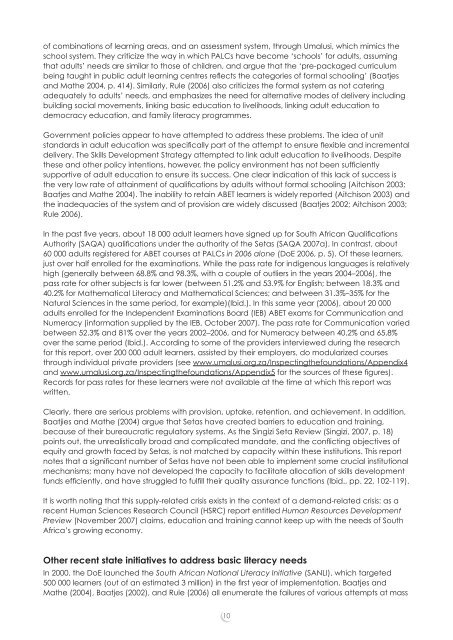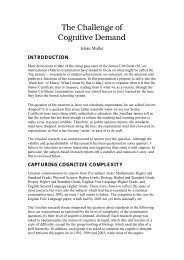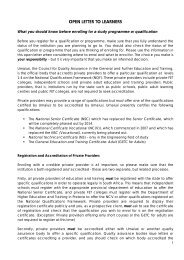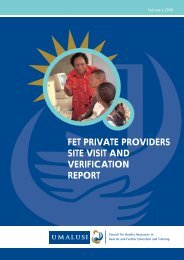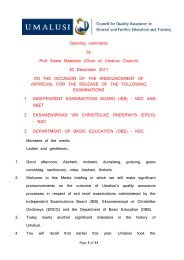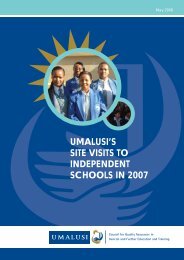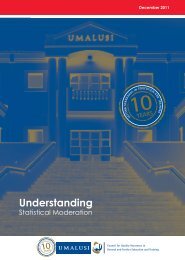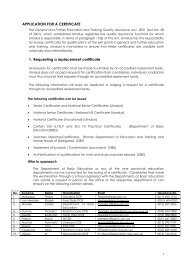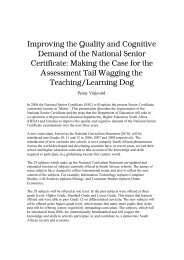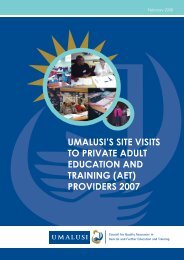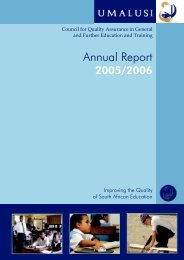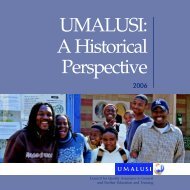Inspecting the Foundations - Umalusi
Inspecting the Foundations - Umalusi
Inspecting the Foundations - Umalusi
Create successful ePaper yourself
Turn your PDF publications into a flip-book with our unique Google optimized e-Paper software.
of combinations of learning areas, and an assessment system, through <strong>Umalusi</strong>, which mimics <strong>the</strong>school system. They criticize <strong>the</strong> way in which PALCs have become ‘schools’ for adults, assumingthat adults’ needs are similar to those of children, and argue that <strong>the</strong> ‘pre-packaged curriculumbeing taught in public adult learning centres refl ects <strong>the</strong> categories of formal schooling’ (Baatjesand Ma<strong>the</strong> 2004, p. 414). Similarly, Rule (2006) also criticizes <strong>the</strong> formal system as not cateringadequately to adults’ needs, and emphasizes <strong>the</strong> need for alternative modes of delivery includingbuilding social movements, linking basic education to livelihoods, linking adult education todemocracy education, and family literacy programmes.Government policies appear to have attempted to address <strong>the</strong>se problems. The idea of unitstandards in adult education was specifi cally part of <strong>the</strong> attempt to ensure fl exible and incrementaldelivery. The Skills Development Strategy attempted to link adult education to livelihoods. Despite<strong>the</strong>se and o<strong>the</strong>r policy intentions, however, <strong>the</strong> policy environment has not been suffi cientlysupportive of adult education to ensure its success. One clear indication of this lack of success is<strong>the</strong> very low rate of attainment of qualifi cations by adults without formal schooling (Aitchison 2003;Baatjes and Ma<strong>the</strong> 2004). The inability to retain ABET learners is widely reported (Aitchison 2003) and<strong>the</strong> inadequacies of <strong>the</strong> system and of provision are widely discussed (Baatjes 2002; Aitchison 2003;Rule 2006).In <strong>the</strong> past fi ve years, about 18 000 adult learners have signed up for South African Qualifi cationsAuthority (SAQA) qualifi cations under <strong>the</strong> authority of <strong>the</strong> Setas (SAQA 2007a). In contrast, about60 000 adults registered for ABET courses at PALCs in 2006 alone (DoE 2006, p. 5). Of <strong>the</strong>se learners,just over half enrolled for <strong>the</strong> examinations. While <strong>the</strong> pass rate for indigenous languages is relativelyhigh (generally between 68.8% and 98.3%, with a couple of outliers in <strong>the</strong> years 2004–2006), <strong>the</strong>pass rate for o<strong>the</strong>r subjects is far lower (between 51.2% and 53.9% for English; between 18.3% and40.2% for Ma<strong>the</strong>matical Literacy and Ma<strong>the</strong>matical Sciences; and between 31.3%–35% for <strong>the</strong>Natural Sciences in <strong>the</strong> same period, for example)(Ibid.). In this same year (2006), about 20 000adults enrolled for <strong>the</strong> Independent Examinations Board (IEB) ABET exams for Communication andNumeracy (information supplied by <strong>the</strong> IEB, October 2007). The pass rate for Communication variedbetween 52.3% and 81% over <strong>the</strong> years 2002–2006, and for Numeracy between 40.2% and 65.8%over <strong>the</strong> same period (Ibid.). According to some of <strong>the</strong> providers interviewed during <strong>the</strong> researchfor this report, over 200 000 adult learners, assisted by <strong>the</strong>ir employers, do modularized coursesthrough individual private providers (see www.umalusi.org.za/<strong>Inspecting</strong><strong>the</strong>foundations/Appendix4and www.umalusi.org.za/<strong>Inspecting</strong><strong>the</strong>foundations/Appendix5 for <strong>the</strong> sources of <strong>the</strong>se fi gures).Records for pass rates for <strong>the</strong>se learners were not available at <strong>the</strong> time at which this report waswritten.Clearly, <strong>the</strong>re are serious problems with provision, uptake, retention, and achievement. In addition,Baatjies and Ma<strong>the</strong> (2004) argue that Setas have created barriers to education and training,because of <strong>the</strong>ir bureaucratic regulatory systems. As <strong>the</strong> Singizi Seta Review (Singizi, 2007, p. 18)points out, <strong>the</strong> unrealistically broad and complicated mandate, and <strong>the</strong> confl icting objectives ofequity and growth faced by Setas, is not matched by capacity within <strong>the</strong>se institutions. This reportnotes that a signifi cant number of Setas have not been able to implement some crucial institutionalmechanisms; many have not developed <strong>the</strong> capacity to facilitate allocation of skills developmentfunds effi ciently, and have struggled to fulfi ll <strong>the</strong>ir quality assurance functions (Ibid., pp. 22, 102-119).It is worth noting that this supply-related crisis exists in <strong>the</strong> context of a demand-related crisis: as arecent Human Sciences Research Council (HSRC) report entitled Human Resources DevelopmentPreview (November 2007) claims, education and training cannot keep up with <strong>the</strong> needs of SouthAfrica’s growing economy.O<strong>the</strong>r recent state initiatives to address basic literacy needsIn 2000, <strong>the</strong> DoE launched <strong>the</strong> South African National Literacy Initiative (SANLI), which targeted500 000 learners (out of an estimated 3 million) in <strong>the</strong> fi rst year of implementation. Baatjes andMa<strong>the</strong> (2004), Baatjes (2002), and Rule (2006) all enumerate <strong>the</strong> failures of various attempts at mass10


